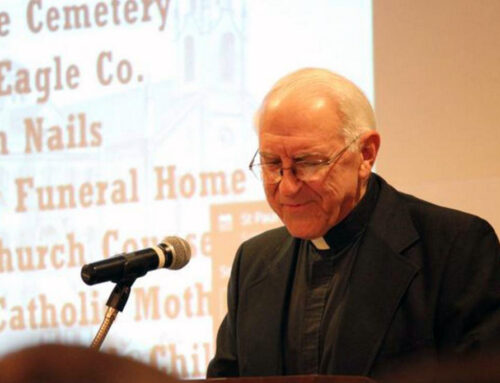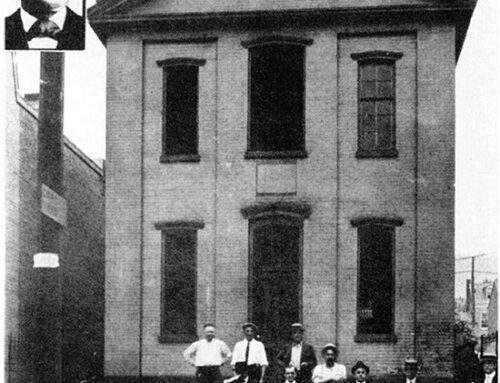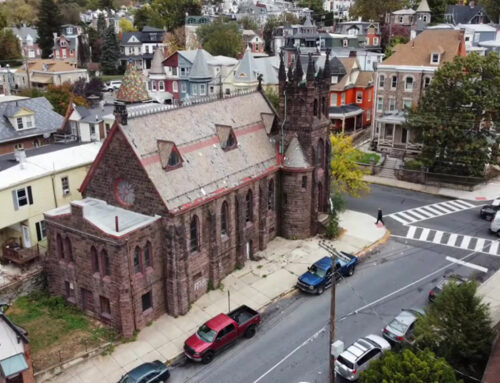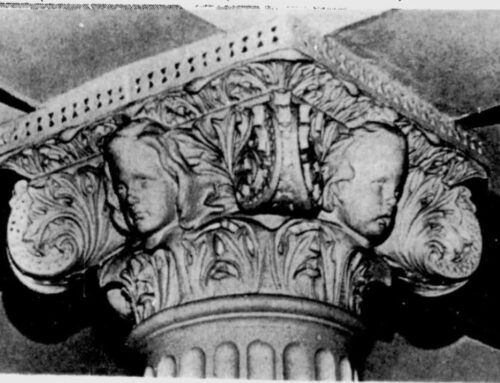Around 1880, the first Slovaks came to Reading from Saris, Spis and Zemplin, areas in Czechoslovakia, and later from Trencin, Orava and Nitra, also in Czechoslovakia. During their first years in Reading, they attended Mass at St. Paul’s Roman Catholic Church, and then at St. Mary’s parish. There were only a few families, but the number soon increased until in 1894, there were about forty families.
In December 1895, the Slovaks organized a parish through the efforts of the Slovac Society of St. John the Baptist, local branch 175. Father Abt was appointed to serve as pastor. With help and counsel of Monsignor Bornemann, rector of St. Paul’s Church, the Slavs purchased an edifice belonging to the Greek Catholic Rite in Oakbrook. The parish was named “Assumption of the Blessed Virgin.”
Below: First Church – 1895.

In 1905, Rev. Francis Horvath, rector of the parish, succeeded in purchasing property at the northeast corner of 6th and Laurel streets so that a church could be located near the homes of most of the parishioners. Father Horvath had been in charge of the congregation for nearly a year. He was a native of Hungary, where he was ordained to the priesthood. He had been in the country 14 years and came to the parish from Cleveland. There was not enough money to erect the edifice fully, but the basement was completed. It was at that time that the parish name was changed to SS. Cyril and Methodius.
On Sunday afternoon, Sept. 23, 1906, the corner-stone of the new Slovac Catholic Church was laid with very elaborate ceremonies. There was a street parade, in which hundreds of members of this and other catholic congregations participated as members of various church societies. The ceremonies were conducted by Monsignor Heinan, of Mauch Chunk, Vicar General of foreign Catholics of the archdiocese of Philadelphia, and were assisted by Rev. Father Horvarth, pastor of the Slovac congregation, and a dozen other priests from Reading and other cities. Several of the out-of-town societies arrived in Reading in the morning and attended mass in the Slovac Church in Oakbrook.
The lacing of the corner-stone of the new edifice took place at 4 p.m. At about 2 o’lock the different societies formed for parade at Sixth and Willow. To the music of a dozen bands and with flying banners and flags, the parade moved over the following route: Up Sixth to Bingaman, to Tenth, to Penn. to Ninth, to St Paul’s Catholic Church parsonage at Ninth and Walnut. Here the procession was joined by Monsignor Heinan, accompanied by Rev. Dr. George Bornemann, pastor of St. Paul’s and by half a dozen other Catholic priests, all riding in carriages. The parade countermarched at Ninth and Walnut and proceeded to Franklin, thence to Seventh, several organizations joining the procession at the depot. The parade moved down Franklin to Fifth, thence to Laurel and back to the church. Sixth and Laurel Str., in the vicinity of the new edifice, were crowded with people. A number of residences were decorated with flags and bunting. A strong floor had been constructed in the partly completed church for the accommodation of those participating in the ceremonies.
The parade, which was one of the most elaborate church turnouts held in Reading for some time, was headed by the following church trustees as chief marshals: John Jakabeln, Mattis Katrinak and Andrew Cmorey. Among the bands in line were the following: Perseverance, of Lebanon, Reading Military, Ringgold, Colonial, White Eagle (Polish) and Italian. The priests rode in three carriages. The parade was headed by a band and then came St. Mary’s parochial school children, followed by the Knights of St. Cassimer of Roman Guards, of St. Mary’s Church. With their gorgeous red and blue suits and glittering helmets they made a striking appearance. Then came a number of young girls attired in blue skirts with red trimmings, white waists and white hats. They carried the American flags. Next in line were the following lodges: The Holy Family and St. Stephen societies from Lebanon, St. Stanislaus, St. Mary’s Queen of Poland, Italian Society Spartaco, Sacred Heart of Jesus, St. Albert, two societies of St. Michael, St. Aloysius and Holy Family societies, all connected with either St. Mary’s Church of the Holy Rosary or Slovac churches of Reading.
Over the entrance were displayed life-size paintings of Saints Cyril and Methodius, after whom the church is named. On either side of the entrance were large pots of oleanders and other plants. There was also a canopy under which stood those participating in the ceremonies. Chairs were provided for the attending priests. As Monsignor Heinan took his position, Elizabeth Jakabeln, eight years old, daughter of John Jakabeln, one of the trustees came up to him and in a beautiful poem, presented him with a bouquet of flowers. Then came the ceremonies, which opened with the chanting of the litanies. After the liturgical prayers the trowel was blessed and the corner-stone was laid by Monsignor Heinan.
The Slovac address was delivered by Rev. Simon Wlosak, of Bethlehem. He entreated the people to be faithful to their church at all times. Monsignor Heinan made an address in English. He spoke of the great success of the congregation in beginning the erection of such a magnificent edifice. He referred to the work of Rev. Father Meresz, of Phila., in the early organization of the congregation in Reading some years ago, and paid high tribute to the energy of Father Horvarth, the present pastor, in starting the church building. The trustees and other church officials came in for high compliment. Monsignor Heinan reminded his listeners that to be a good Catholic is to be a good citizen. He urged each of them to do all in his power to bring about the early completion of the church and payment of the same. A collection wan taken up and a goodly sum realized. The congregation then dispersed.
Among the priests in attendance, besides those already mentioned, were the following: Rev. Father Jedliska, of Mahanoy City; Rev. Father Fuengerling, of St. Paul’s, this city; Rev. Thomas J. McCarty, of St. Peter’s, this city, Rev. Martin Meresz, former pastor of the Slovac Church, now of Phila., Rev. Father Malusecki, of St. Mary’s Church, this city, and his assistant, Rev. Father Natulsky.
It would take about nine years before the church was completed. Construction of the new edifice halted at the completion of the basement, on account of lack of funds. For several years, services had been conducted regularly in the basement.
In 1911, Rev. Fridolin Ravnikar became the pastor and renewed the efforts to complete the church. Construction of the new church was resumed in 1913. Ultimately $40,000 was raised to finish the structure.
On Sunday, July 5, 1914 dedication services were held at SS. Cyril and Methodius for the completion of the church. As early as 9 o’clock Sunday morning, hundreds of people, aliens and Americans, were grouped about the imposing building to witness the ceremonies. Many of them had hoped to see Archbishop Prendergast, of the Philadelphia archdiocese, who was to have dedicated the building, but who had to cancel the engagement at the last minute. While his absence was a great disappointment, the dedication was just as successfully elaborate with the Rt. Rev. Mr. George Bornemann, the venerable rector of St. Paul’s Roman Catholic Church, this city, in the role of dedicator.
Below: SS. Cyril and Methodius Church (1914)

Sixth Street was a mass of people, who easily numbered 2,000, while the ceremonies were on. A parade which preceded the dedication was an inspiring spectacle, all the Polish, Slovac and Greek Catholic societies banding in one big body to celebrate the achievement of several years’ efforts. The parade stretched for many squares and was composed of many out-of-town organizations as well as the local bodies. The Reading Eagle called it “one of the most elaborate celebrations in the history of the Roman Catholic Church in Reading.” At least 17 bands accompanied the 20 lodges and made the pageant more striking. All of Reading’s leading musical organizations were among the bands, such as the Ringgold, Philharmonic, Colonial, National Drum Corps, Cadet, etc. The visiting lodges were accompanied by bands.
The parade was divided into three divisions, consisting of the following organizations: Catholic Falcons, of South Bethlehem; St. Mary’s Greek Catholic Society of Reading; Pennsylvania Slovac Union, of Reading; National Slovac Society, of Reading; Leaf of Free Eagle, of Reading; Woodmen of the World, of Reading; Polish Knights of St. Casimir, of Reading; branch of the Catholic Union, of Lebanon; National Slovac Society, of Lebanon; two branches of the Catholic Union, of Mahanoy City; branch of the Catholic Union, of Pottstown; St. Stanislaus Polish Lodge, of Reading; Polish Riflemen, of Reading; branch of the Catholic Union, of Phoenixville; St. George Croatians, of Reading; Queen of Poland Society, of Reading: St. Anthony Lithuanian Lodge, of Reading; St. Joseph’s Polish Society, of Reading.
The parade started from the outer station of the Reading Railway, where the visiting organizations were met upon their arrival here and was headed by George Jakabein, as chief marshal, and Andrew Mashar, assistant marshal. The other three assistant marshals who lead the first, second and third divisions, were Paul Kollar, John Vrabel and John Lendacki. The route was as follows: In Sixth street to Penn, down Penn to Fourth, countermarch to Sixth, down Sixth to Willow, up Willow to Seventh, countermarch to Sixth, up Sixth to Laurel.
Upon the arrival of the parades at the church there was a procession of clergymen and seminarians from the rectory to the church. John Hasson, a student at Overbrook, was, in the lead as cross bearer, with Robert Buckley and Felix Fink as acolytes. William Fogarty and Ray¬mond Ganter, also students at Overbrook, followed with the incense. Then came Monsignor Bornermann, cloaked in the cardinal red cassock and white surplice and crowned with a monsignor’s baretta, with the holy water with which he blessed the exterior of the church as the procession continued around the outside of the edifice. Other clergymen participating in the dedication were Rev John F. Kiernan, rector of St. Peter’s Roman Catholic Church; Rev. James Flanagan, rector of St. Joseph’s Roman Catholic Church; Rev. Adalbert Malusecki, rector of St Mary’s Roman Catholic Church. After blessing the exterior, Monsignor Bornemann entered the interior of the church and continued the dedication by sprinkling the holy water upon the walls and altars while accompanying clergymen assisted in the chanting. After the dedication, all the paraders marched in single file through one entrance to the church and came out of another, after getting a good view of the structure.
It was nearly noon when the solemn high mass was begun by Monsignor Bornemann; Father Malusecki as deacon; and Leo Fink, a student at Overbrook, as sub-deacon. In the sanctuary were the seminary students, including Luke Stahl, William Fogarty, Felix Fink, Robert Buckley, Raymond Ganter; and several clergymen, Rev. Dr. Eugene Marchetti, rector of the Holy Rosary Roman Catholic Church; Rev. John Daniel, assistant rector of St. Paul’s; Rev. A. Kaminski, of Milhnont; Rev. E. Kuntz, of Hyde Park; Rev. Oscar Suster, of Phoenixville, former rector of Sts. Cyril and Methodius; Rev. Father Vichoidil, of Allentown, and Fathers Kiernan and Flanagan, of St. Peter’s and St. Joseph’s respectively.
The dedication sermon was delivered by Rev. M. Dondalek, of Pottstown, who had nothing but congratulations for the members. He asked them to be good citizens of Reading as well as good Catholics. Father Bornemann said a few words, commending the parish for its rapid growth. He told of the hardships endured by the Slavs to build a church since settling in Reading. He said he clearly remembered when the parish was started and how vigorously the Slavs worked for success. He added. “The Slovac Catholics to Reading are sincere. They proved it by this work. You have always been willing to give your full hand for the uplift of the holy church. You have erected a most beautiful edifice, and for its construction you contributed most generously, which will not be overlooked by the Almighty.” Father Bornemann expressed deep regret that the archbishop was unable to be present, and explained that unfortunate circumstances prevented his appearance on the occasion.
Following the solemn high mass, benediction of the Blessed Sacrament was celebrated for the first time in the new church by Father Bornemann. This culminated the ceremonies at the church. All day long, hundreds of people inspected the structure and praised the work. Congratulations from all sources were heaped upon the rector, Rev. F. H. Ravnikar, who was instrumental in the building of the church, and who was a most conspicuous figure in the day’s exercises.
Realizing the need for a parochial school, Father Ravnikar, purchased a dwelling at the southwest corner of 6th and Laurel streets and converted it into a school, which was dedicated in September 1916. The building was located next to the convent of the Missionary Sisters of the Sacred Heart who taught at the school.
On March 3, 1926, Cardinal Dougherty, archbishop of Philadelphia, appointed the Rev. Michael P. Kakos as pastor, and under his guidance, the parish grew and prospered. The parish mortgage was paid off and money was accumulated for a new school.
In 1933, the Church Boys’ Cadet Band, among the winning of many honors, was the leading band in the inaugural parade for President Franklin Delano Roosevelt.
Below: Boys’ Cadet Band.

In 1939, five properties for the site of a new school were purchased. In December 1945, the church celebrated its golden jubilee. In 1950, ground was broken for a new school on the site of the properties purchased in 1939.
Below: Groundbreaking of New School (1950).

Below: Construction of New School (1950).

On Sunday, April 1, 1951 dedication services were held at SS. Cyril and Methodius for the completion of the completed $250,000 school located at 450 S. 6th St. The Most Rev. Hugh L. Lamb, auxiliary bishop of Philadelphia, officiated at the ceremonies, which began with a Solemn High Mass in the church at 10:30 a. m. and; closed with a benediction at 7:30 p. m. An estimated 1,200 persons attended the dedication services and 1,500 parishioners attended the morning Mass.
Below: Dedication of New School (1951) – Touch or Click Images to Enlarge.
In 1961, SS. Cyril and Methodius becomes part of the newly established Dioceses of Allentown.
In August of 1963, Father Kakos dies after 42 years of priestly labor. Father Lesko, who had been his assistant from 1947 to 1955, was named pastor. The parish continued to grow under his guidance.
In 1966, a property adjoining the rectory at 449 S. 6th St. was purchased. The sisters moved into the building and the old convent was razed. A new convent, costing $90,000, was constructed on the sites of the old convent and school. This building was dedicated in March 1967. The Most Rev. Joseph McShea, bishop of the Allentown Diocese of the Roman Catholic Church, officiated at the blessing.
In 1969, a new air conditioning unit was purchased, and modern pews and carpeting were installed throughout the church.
On Sunday, November 8, 1970, SS. Cyril and Methodius Roman Catholic Church of Reading observed its 75th jubilee. A Mass of Thanksgiving was celebrated by the Most Rev. Joseph McShea, bishop of the Allentown Roman Catholic Diocese. At 6 p.m., a jubilee banquet was held in the Abraham Lincoln Hotel with the Very Rev. Charles Patrick as the principal speaker. The Rev. Michael A. Lesko, pastor, was general chairman of the committee that had been planning the celebration. He was assisted by George Zdravecki, Frank Katrinak, Albert Monick, Michael Zahurak, Helen Kalina and Verna E. Stasik.
In 1979, Father Lesko built a new rectory on the expanded site of the old one. In 1981, Rev. Vincent York was appointed pastor following the death of Father Lesko in April of that year.
In 1982, the Parish School, which closed in 1979, was re-dedicated for use as the John Paull II Center for special needs students.
In 1989, a major renovation and painting of the Church was done to bring the official appointments up to required liturgical standards.
In 1991, Father York was transferred to St. Ursula’s parish in Fountain Hill. Father Charles Sperlak replaced him in October.
In 1994, preparations were begun for the Centennial Celebration of the Church. The Centennial Year was inaugurated on October 2nd, with an opening Mass and dinner.
On October 28, 1995, SS. Cyril and Methodius Roman Catholic Church observed its 100th anniversary. Bishop Thomas J. Welsh celebrated a Pontifical Mass of Thanksgiving and was joined by the Rev. Charles Sperlak, pastor, and the Rev. Joseph Tobias, son of the parish, who was homilist. On hand for the anniversary celebration were Rev. Vincent York, rector of SS. Cyril and Methodius Church, and three sons of the parish besides Tobias – the Revs. Francis Straka, George Palick and Daniel Cipar. Cantor was Susan Fessler. Special music was provided by the Basic’ly Brass quartet, Ringaleers handbell choir, special orchestra and parish choir directed by David Kostival. A banquet/dance attended by 400 at Riveredge followed, at which Welsh spoke about the dedicated ministry of Cyril and Methodius. Toastmaster was state Sen. Michael A. O’Pake. The oldest parishioner present, Elizabeth Latshaw, 91, was singled out for a special blessing.
Below: 100th Anniversary Mass (10/28/1995) – Touch or Click Images to Enlarge.
In 1999, to provide off-street parking, Rev. Charles Sperlak razed the buildings across from the church at 462 and 464 S. Sixth St. (now the church parking lot). One of the buildings was donated to the church by a member, Mary Petro, specifically for the purpose of demolition so parking could be created. The adjacent building was purchased by the diocese at an auction for $15,000, plus auctioneer’s fees and settlement of unpaid taxes.
Rev. Charles S. Sperlak, pastor from 1991 until his retirement on October 5, 2015, passed away November 19, 2015, in Holy Family Villa for Priests, Bethlehem. A Mass of Christian Burial was celebrated on November 23, 2015, in SS. Cyril & Methodius Church by His Excellency, the Most Reverend John O. Barres, D.D., Bishop of Allentown. Due to a diocese wide shortage of priests, Rev. Charles S. Sperlak was replaced by an administrator.
Since 1895, SS. Cyril and Methodius Roman Catholic Church, has had many pastors. The longest pastorate was held by the Rev. Michael P. Kakos, who served 37 years, 1926-63. Below is a list of former pastors, including many not mentioned above:
1895 – Father Abt
1896 – Father George Michal
1897 – Rev. Josef Kasparek
1898 – Rev. Martin Meres
1900 – Fr. Leopold Schifferdecker replaces Fr. Meres for a short time. Later that year Fr. Meres returns. Fr. Meres is transferred to Philadelphia. No pastor is immediately reappointed.
1904 – Fr. Francis Horvath
1907 – Fr. Joseph Pospech
1908 – Father Paul Herman
1908 – Father Oscar
1911 – Fr. Bernard Sommers
1911 – Fr. Fridolin Ravnikar
1921 – Father Jan Zbojovsky
1924 – Fr. Joseph Horacek
1926 – Father Michael Kakos
1963 – Father Michael Lesko
1981 – Father Vincent York
1991 – 2015, Father Charles Sperlak










Leave A Comment